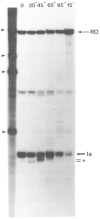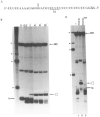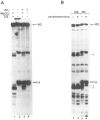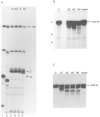The RNA polymerase II elongation complex. Factor-dependent transcription elongation involves nascent RNA cleavage
- PMID: 1379232
- PMCID: PMC3371615
The RNA polymerase II elongation complex. Factor-dependent transcription elongation involves nascent RNA cleavage
Abstract
Regulation of transcription elongation is an important mechanism in controlling eukaryotic gene expression. SII is an RNA polymerase II-binding protein that stimulates transcription elongation and also activates nascent transcript cleavage by RNA polymerase II in elongation complexes in vitro (Reines, D. (1992) J. Biol. Chem. 267, 3795-3800). Here we show that SII-dependent in vitro transcription through an arrest site in a human gene is preceded by nascent transcript cleavage. RNA cleavage appeared to be an obligatory step in the SII activation process. Recombinant SII activated cleavage while a truncated derivative lacking polymerase binding activity did not. Cleavage was not restricted to an elongation complex arrested at this particular site, showing that nascent RNA hydrolysis is a general property of RNA polymerase II elongation complexes. These data support a model whereby SII stimulates elongation via a ribonuclease activity of the elongation complex.
Figures





Similar articles
-
Transcription factors TFIIF, ELL, and Elongin negatively regulate SII-induced nascent transcript cleavage by non-arrested RNA polymerase II elongation intermediates.J Biol Chem. 2001 Jun 22;276(25):23109-14. doi: 10.1074/jbc.M101445200. Epub 2001 Mar 19. J Biol Chem. 2001. PMID: 11259417
-
Nascent RNA cleavage by arrested RNA polymerase II does not require upstream translocation of the elongation complex on DNA.J Biol Chem. 1993 Dec 5;268(34):25604-16. J Biol Chem. 1993. PMID: 7503982 Free PMC article.
-
The increment of SII-facilitated transcript cleavage varies dramatically between elongation competent and incompetent RNA polymerase II ternary complexes.J Biol Chem. 1993 Jun 15;268(17):12874-85. J Biol Chem. 1993. PMID: 8509421
-
The RNA polymerase II general elongation factors.Trends Biochem Sci. 1996 Sep;21(9):351-5. Trends Biochem Sci. 1996. PMID: 8870500 Free PMC article. Review.
-
Transcription elongation factor SII.Bioessays. 2000 Apr;22(4):327-36. doi: 10.1002/(SICI)1521-1878(200004)22:4<327::AID-BIES3>3.0.CO;2-4. Bioessays. 2000. PMID: 10723030 Free PMC article. Review.
Cited by
-
Transcription elongation. Heterogeneous tracking of RNA polymerase and its biological implications.Transcription. 2014;5(1):e28285. doi: 10.4161/trns.28285. Transcription. 2014. PMID: 25764114 Free PMC article. Review.
-
In vitro activity of the baculovirus late expression factor LEF-5.J Virol. 2002 Dec;76(24):12663-75. doi: 10.1128/jvi.76.24.12663-12675.2002. J Virol. 2002. PMID: 12438592 Free PMC article.
-
Efficient and rapid nucleosome traversal by RNA polymerase II depends on a combination of transcript elongation factors.J Biol Chem. 2011 Feb 25;286(8):6040-8. doi: 10.1074/jbc.M110.174722. Epub 2010 Dec 22. J Biol Chem. 2011. PMID: 21177855 Free PMC article.
-
A novel RNA polymerase I-dependent RNase activity that shortens nascent transcripts from the 3' end.Proc Natl Acad Sci U S A. 1996 Nov 12;93(23):12914-9. doi: 10.1073/pnas.93.23.12914. Proc Natl Acad Sci U S A. 1996. PMID: 8917519 Free PMC article.
-
Flexible positioning of the telomerase-associated nuclease leads to preferential elimination of nontelomeric DNA.Mol Cell Biol. 1998 Mar;18(3):1544-52. doi: 10.1128/MCB.18.3.1544. Mol Cell Biol. 1998. PMID: 9488471 Free PMC article.
References
-
- Agarwal K, Baek K, Jeon C, Miyamoto K, Ueno A, Yoon H. Biochemistry. 1991;30:7842–7851. - PubMed
-
- Arndt KM, Chamberlin MJ. J. Mol. Biol. 1990;213:79–108. - PubMed
-
- Atkinson MR, Deutscher MP, Kornberg A, Russell AF, Moffatt JG. Biochemistry. 1969;8:4897–4904. - PubMed
-
- Chafin DR, Claussen TJ, Price DH. J. Biol. Chem. 1991;266:9256–9262. - PubMed
Publication types
MeSH terms
Substances
Grants and funding
LinkOut - more resources
Full Text Sources

